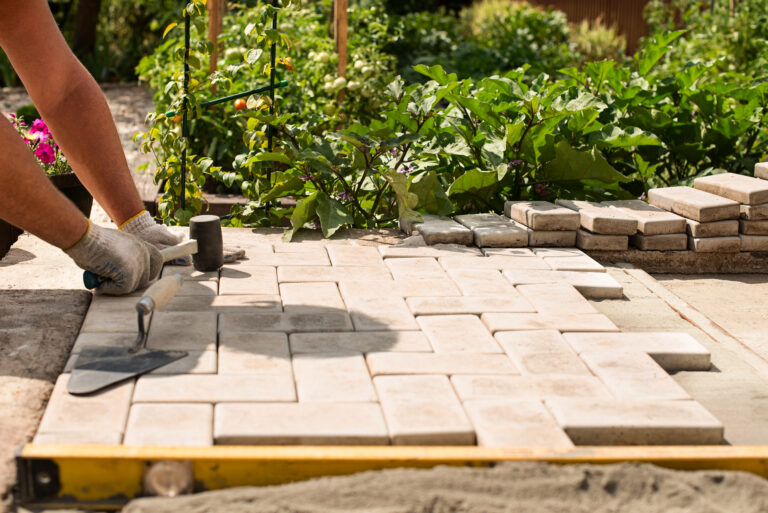Integrating Artificial Turf and Pavers: Enhance Your Outdoor Space with Beauty and Function

Homeowners are constantly seeking ways to elevate the aesthetic appeal and functionality of their outdoor spaces. One innovative approach gaining popularity is the integration of artificial turf with paving stones, creating beautiful and low-maintenance landscapes. This combination provides a unique, visually appealing area for relaxation and entertainment, without the upkeep commonly associated with natural lawns.
The use of artificial turf offers a green, lush appeal year-round, without the need for watering, trimming, or fertilization. By incorporating pavers into the design, the landscape becomes not only visually enticing but also practical, serving as pathways, patios, or even driveways. This synergy of materials reduces the ongoing costs and time-consuming efforts associated with maintaining an immaculate outdoor environment, making it an ideal choice for homeowners with busy lifestyles.
Incorporating artificial turf and pavers into the design of outdoor living spaces provides countless opportunities for creative expression, from intricate patterns and motifs to functional additions such as fire pits or seating areas. By exploring the endless options available, homeowners can ultimately create their ideal outdoor haven, enjoying the advantages of a beautiful, low-maintenance landscape.
Benefits of Integrating Artificial Turf and Pavers
Increased Curb Appeal and Outdoor Enjoyment
Integrating artificial turf and pavers creates a visually appealing and versatile outdoor space. By combining the natural appearance of artificial grass with the texture and design options offered by pavers, homeowners can create an inviting and aesthetically pleasing outdoor oasis. Some options to enhance curb appeal include:
- Varied patterns and layouts: Mix and match paver styles, sizes, and colors for a unique design.
- Soft, even surfaces: Artificial turf provides a comfortable and safe walking area.
- Defined areas: Use pavers to outline spaces for specific activities, such as dining, lounging, and playing.
These design choices allow for greater outdoor enjoyment, making it easy to spend more time outside and encouraging social gatherings with family and friends.
Sustainability and Low-Maintenance Advantages
Using artificial turf and pavers in your outdoor space offers both environmental and practical benefits. This combination creates a sustainable and low-maintenance landscape by:
- Conserving water: Artificial turf eliminates the need for watering, significantly reducing water usage.
- Reducing chemical use: Artificial grass doesn’t require fertilizers or pesticides, promoting eco-friendliness.
- Erosion control: Pavers and artificial turf are durable and resistant to weather-related erosion, maintaining their appearance over time.
| integrating Artificial Turf and Pavers | Benefits |
|---|---|
| Water Conservation | No need for watering |
| Reduction in Chemical Use | No need for fertilizers or pesticides |
| Durability and Erosion Control | Resistant to weather-related erosion |
In addition to these sustainable features, artificial turf and pavers are low-maintenance landscaping options, increasing the appeal of your outdoor space with minimal effort. Some low-maintenance advantages include:
- No mowing or trimming: Artificial grass stays at an even height, reducing the need for regular lawn care.
- Weed control: Pavers can be installed with weed barriers, minimizing weed growth.
- Simple cleaning: Both artificial turf and pavers can be cleaned with a broom or hose, maintaining their appearance with minimal effort.
By integrating artificial turf and pavers in your outdoor space, you can create a beautiful, sustainable, and low-maintenance environment for all to enjoy.
Designing with Artificial Turf and Pavers
In landscape design, integrating artificial turf and pavers can create stunning and functional outdoor spaces. By carefully considering colors, materials, layout, and functionality, you can achieve an outdoor space that is both beautiful and practical.
Choosing Colors and Materials for Harmony
When designing with artificial grass and pavers, it is essential to select colors and materials that complement each other and the surrounding environment. Here are some tips for achieving balance:
- Artificial Grass: Choose synthetic turf that resembles natural grass in color and texture. High-quality artificial grass will have a mixture of green shades and brown thatch for a realistic look.
- Pavers: Opt for natural stone or concrete pavers in neutral colors that work well with the artificial turf. Common choices include travertine, granite, and limestone, as well as concrete pavers which mimic the appearance of natural stone.
- Color Coordination: To create a sense of continuity, consider using similar colors and tones throughout your landscape, including not only your artificial grass and pavers, but also your outdoor furniture, accessories, and surrounding structures.
Layout and Pattern Considerations
While there are endless design possibilities when integrating pavers and artificial turf, certain aspects should be considered for optimal visual appeal and functionality:
- Patios and walkways: Intersperse pavers and artificial grass in alternating patterns to create visually interesting pathways or patio spaces.
- Driveway: Combine pavers with synthetic turf to break up monotonous concrete driveways, adding curb appeal and softening the overall appearance.
- Putting Green: Incorporate artificial turf into a garden path or walkway that leads to a backyard putting green.
- Pattern Variety: Experiment with different paver shapes and layout patterns, such as herringbone, circular, or irregular patterns, to create a unique and personalized landscape design.
Incorporating Functional Areas
A well-designed outdoor space should offer a range of functional areas that cater to various activities and purposes. Some possibilities include:
- Entertainment Area: Utilize pavers to create a stable surface for an outdoor dining or seating area, while surrounding the space with artificial turf. Add an umbrella or pergola for shade and an outdoor kitchen or grill for convenience.
- Play Area: Designate a portion of your yard as a play area with artificial grass, perfect for children’s playsets, trampolines, or even a small soccer field.
- Relaxation Zone: Set aside a quiet corner of your outdoor space to relax, with a hammock or lounge chairs placed on a soft bed of artificial grass.
- Garden Path: Use pavers to create a meandering garden path, surrounded by artificial turf and accented with colorful, low-maintenance plants and outdoor lighting.
Installation Techniques for Artificial Turf and Pavers
Preparing the Base and Drainage System
The first step to integrating artificial turf and pavers is preparing the site. Start by excavating the area to create a stable and leveled surface. Remove weeds, rocks, and debris to ensure proper drainage. A combination of lattice-board landscape design and decomposed granite can create an effective drainage system. The decomposed granite provides a stable base for both artificial turf and pavers, while the lattice-board adds an extra layer of support if placed underneath.
Laying Pavers and Artificial Grass Correctly
To install the pavers and artificial turf, follow these steps:
- Position the pavers: Arrange the pavers according to your desired pattern or design. Make sure they are evenly spaced, and account for any cuts that may be necessary around edges or curves.
- Install the artificial turf: Unroll the turf and trim any excess material. Position the turf so that the seams align properly, ensuring a seamless appearance. To connect the seams, use a combination of nails and adhesive.
- Fill the gaps: Spread decomposed granite in the gaps between pavers, leveling it to create a stable surface.
- Secure the turf: Nail or staple the edges of the artificial turf along the perimeter of the entire installation area, ensuring a secure fit.
Ensuring Longevity and Durability
To ensure that your artificial turf and pavers remain durable and stable, follow these tips:
- Proper drainage: To minimize water accumulation, ensure your drainage system is adequate. Incorporate drains or grading that directs water away from the foundation of your driveway or other hardscape features.
- Maintenance: Regularly remove debris from the surface of the turf and pavers to prevent mold or mildew.
- Inspection: Periodically check the seams for signs of wear or damage, and monitor the turf for any signs of degradation or wear.
By following these installation techniques and maintenance tips, your artificial turf and pavers will provide you with a beautiful and durable outdoor space for years to come.






